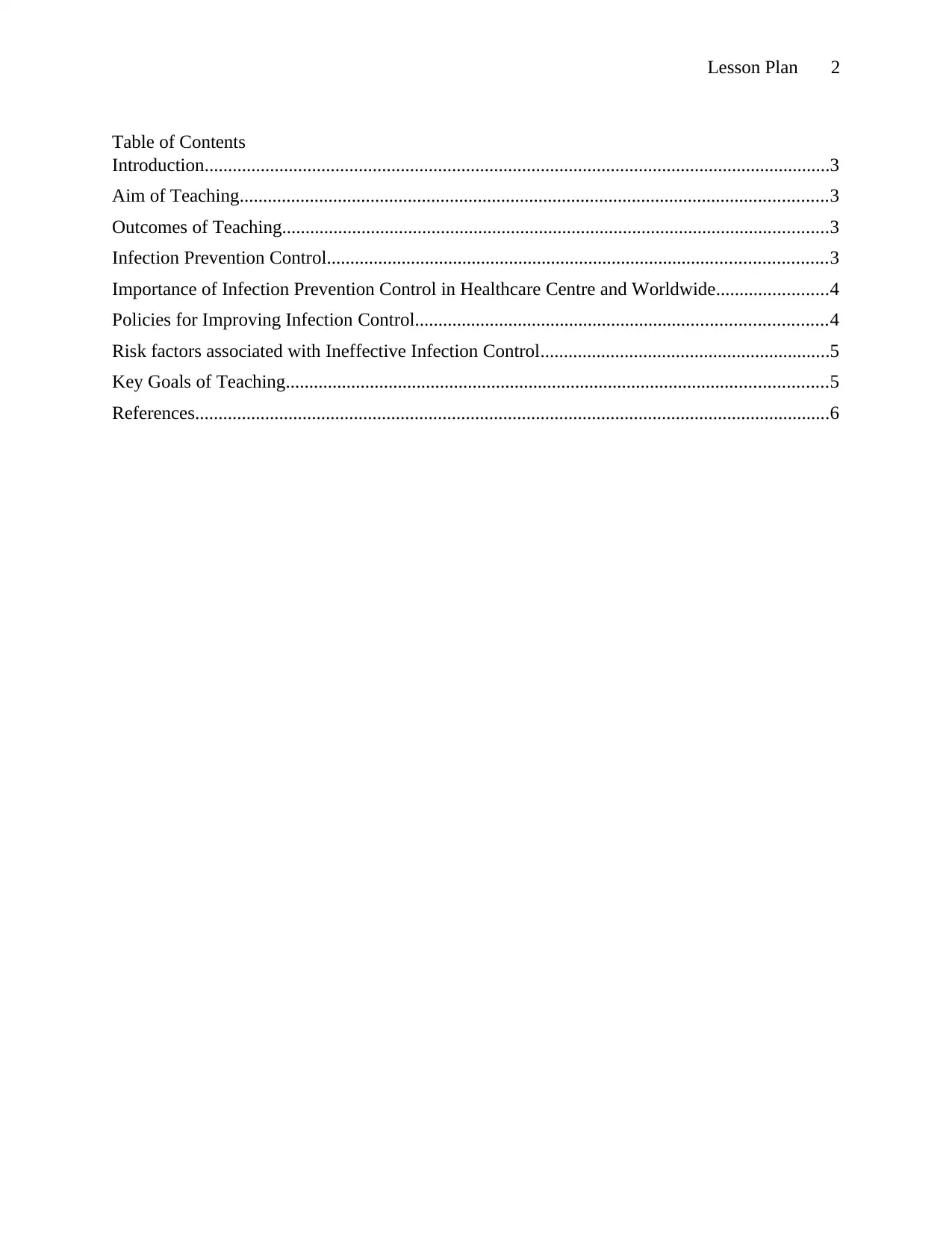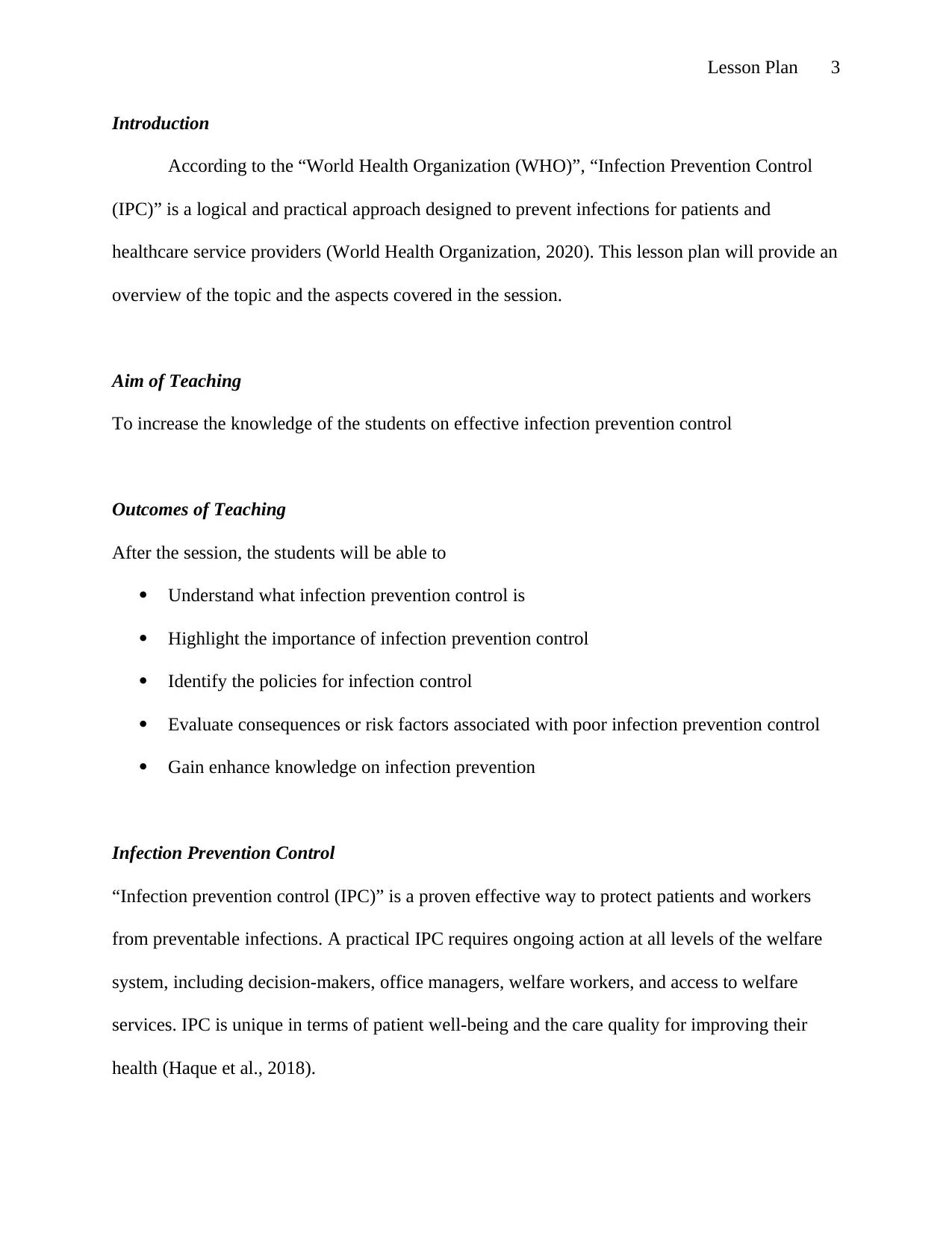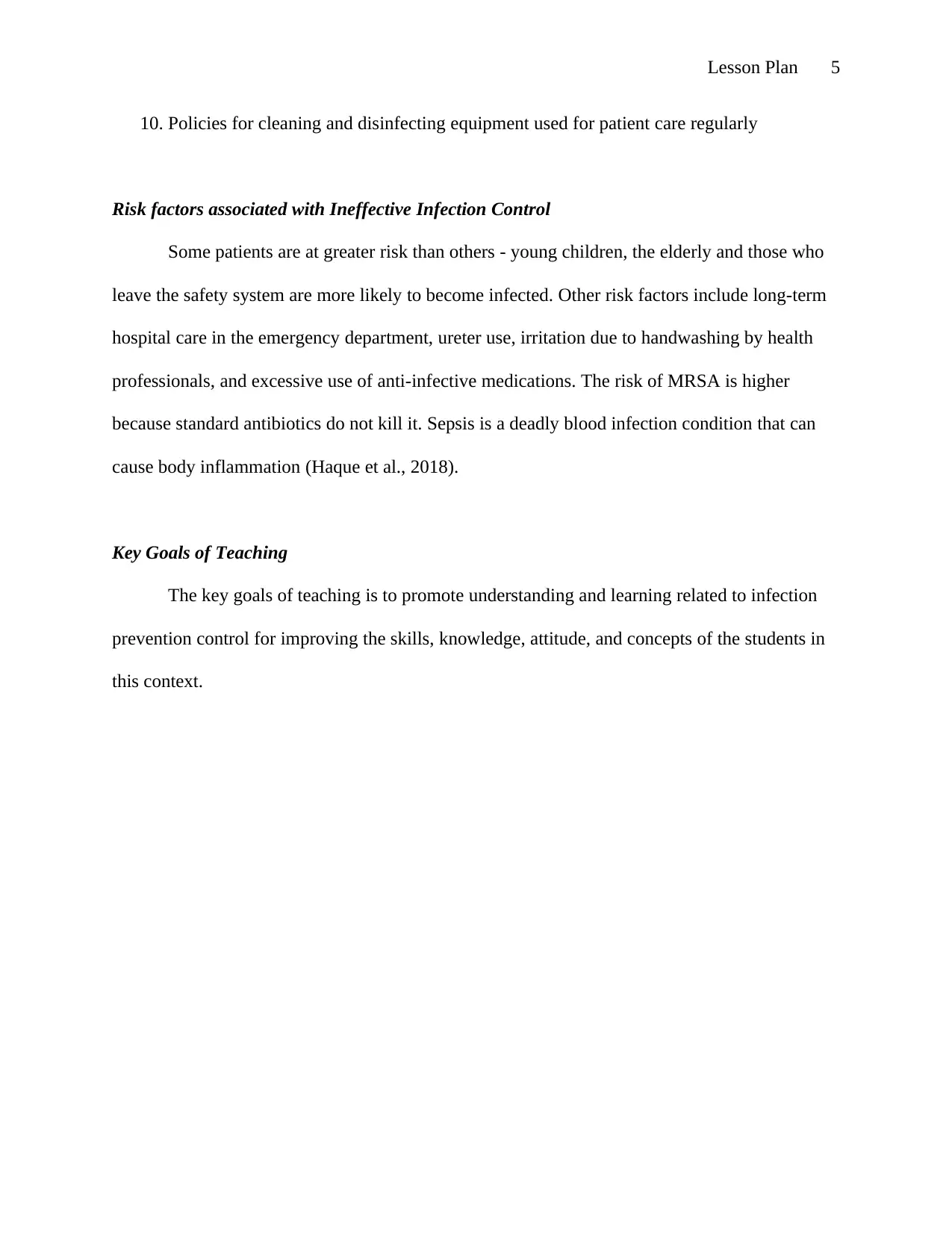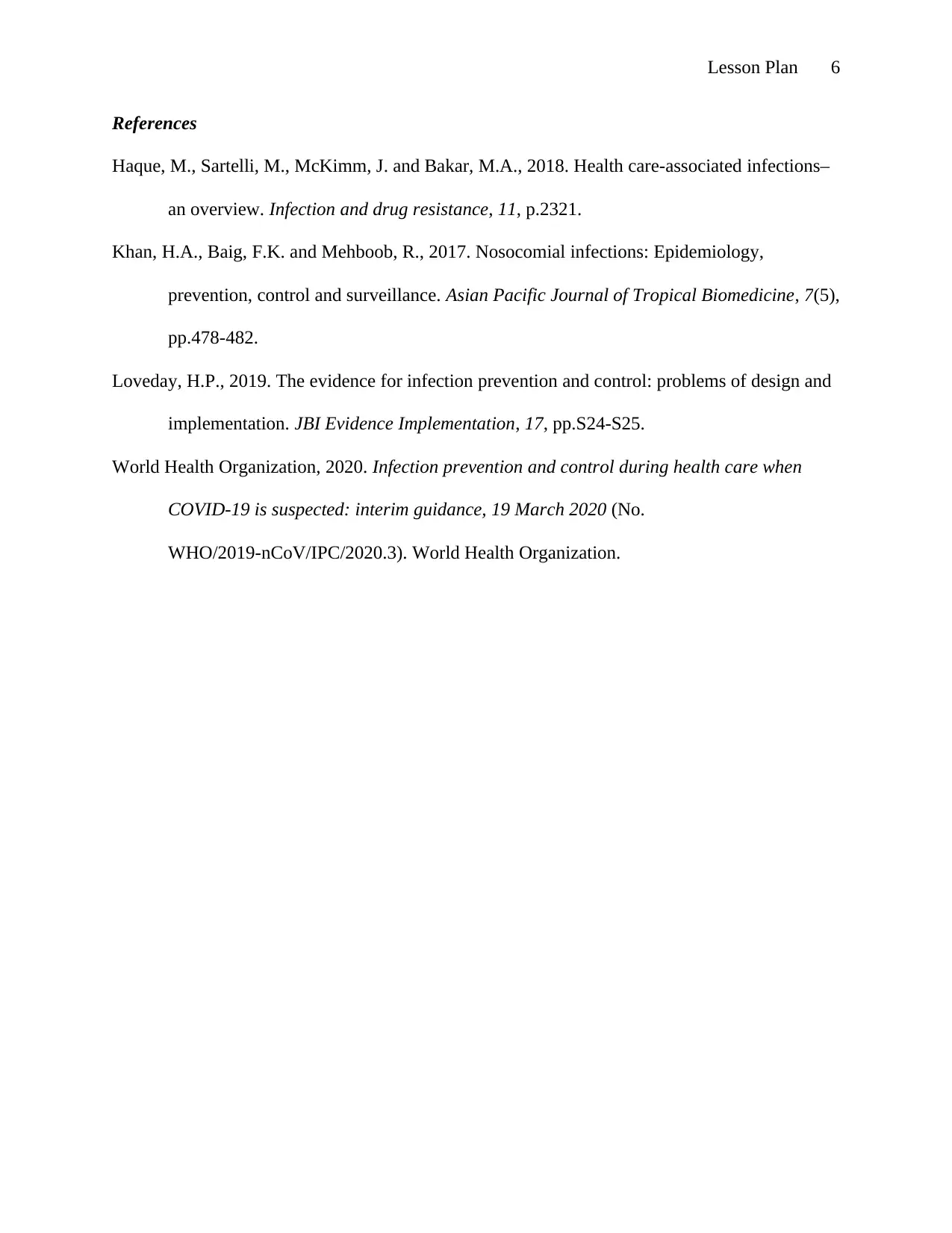Lesson Plan: Infection Prevention Control in Healthcare Module
VerifiedAdded on 2021/11/19
|6
|777
|120
Homework Assignment
AI Summary
This lesson plan focuses on Infection Prevention Control (IPC) in healthcare, emphasizing its importance in protecting patients and healthcare workers. It outlines the aim of teaching, which is to increase student knowledge on effective IPC, and details the expected learning outcomes, including understanding IPC, highlighting its significance, identifying relevant policies, evaluating risk factors, and gaining enhanced knowledge. The plan covers the definition of IPC, its importance in healthcare settings globally, and policies for improvement, such as maintaining hand hygiene, wearing protective gear, and proper waste management. It also discusses risk factors associated with ineffective IPC, including vulnerable patient populations and overuse of antibiotics. The lesson plan concludes by identifying key teaching goals aimed at promoting understanding and improving students' skills and knowledge related to IPC. References from WHO and other sources are included to support the information provided.

Running Head: LESSON PLAN
Infection Prevention Control
[Name of Student]
[Date]
Infection Prevention Control
[Name of Student]
[Date]
Paraphrase This Document
Need a fresh take? Get an instant paraphrase of this document with our AI Paraphraser

Lesson Plan 2
Table of Contents
Introduction......................................................................................................................................3
Aim of Teaching..............................................................................................................................3
Outcomes of Teaching.....................................................................................................................3
Infection Prevention Control...........................................................................................................3
Importance of Infection Prevention Control in Healthcare Centre and Worldwide........................4
Policies for Improving Infection Control........................................................................................4
Risk factors associated with Ineffective Infection Control..............................................................5
Key Goals of Teaching....................................................................................................................5
References........................................................................................................................................6
Table of Contents
Introduction......................................................................................................................................3
Aim of Teaching..............................................................................................................................3
Outcomes of Teaching.....................................................................................................................3
Infection Prevention Control...........................................................................................................3
Importance of Infection Prevention Control in Healthcare Centre and Worldwide........................4
Policies for Improving Infection Control........................................................................................4
Risk factors associated with Ineffective Infection Control..............................................................5
Key Goals of Teaching....................................................................................................................5
References........................................................................................................................................6

Lesson Plan 3
Introduction
According to the “World Health Organization (WHO)”, “Infection Prevention Control
(IPC)” is a logical and practical approach designed to prevent infections for patients and
healthcare service providers (World Health Organization, 2020). This lesson plan will provide an
overview of the topic and the aspects covered in the session.
Aim of Teaching
To increase the knowledge of the students on effective infection prevention control
Outcomes of Teaching
After the session, the students will be able to
Understand what infection prevention control is
Highlight the importance of infection prevention control
Identify the policies for infection control
Evaluate consequences or risk factors associated with poor infection prevention control
Gain enhance knowledge on infection prevention
Infection Prevention Control
“Infection prevention control (IPC)” is a proven effective way to protect patients and workers
from preventable infections. A practical IPC requires ongoing action at all levels of the welfare
system, including decision-makers, office managers, welfare workers, and access to welfare
services. IPC is unique in terms of patient well-being and the care quality for improving their
health (Haque et al., 2018).
Introduction
According to the “World Health Organization (WHO)”, “Infection Prevention Control
(IPC)” is a logical and practical approach designed to prevent infections for patients and
healthcare service providers (World Health Organization, 2020). This lesson plan will provide an
overview of the topic and the aspects covered in the session.
Aim of Teaching
To increase the knowledge of the students on effective infection prevention control
Outcomes of Teaching
After the session, the students will be able to
Understand what infection prevention control is
Highlight the importance of infection prevention control
Identify the policies for infection control
Evaluate consequences or risk factors associated with poor infection prevention control
Gain enhance knowledge on infection prevention
Infection Prevention Control
“Infection prevention control (IPC)” is a proven effective way to protect patients and workers
from preventable infections. A practical IPC requires ongoing action at all levels of the welfare
system, including decision-makers, office managers, welfare workers, and access to welfare
services. IPC is unique in terms of patient well-being and the care quality for improving their
health (Haque et al., 2018).
⊘ This is a preview!⊘
Do you want full access?
Subscribe today to unlock all pages.

Trusted by 1+ million students worldwide

Lesson Plan 4
Importance of Infection Prevention Control in Healthcare Centre and Worldwide
Infection control affects all aspects of healthcare, including hand hygiene, antibiotic
treatment, and the operation of hospitals in emergencies and outdoors (Loveday, 2019). IPC
support programs are particularly important in low- and middle-income countries, where
comorbidities can adversely affect the delivery of medical services and clinical cleansing
policies. Without a strong IPC, it is difficult to provide good medical care. Infection control and
surveillance affect all parts of the health service, including hand hygiene, careful on-site
contamination, infusion safety, antibiotic surveillance, and the operation of hospitals in
emergencies and outdoors (Khan et al., 2017).
Policies for Improving Infection Control
The most important initial step is to develop appropriate policies to prevent infections. Below
are infection control policies every hospital should have:
1. Maintaining hand hygiene
2. Wearing gown to protect skin and cloth from getting an infection
3. Face protection from blood, secretions, and fluids
4. Prevention and avoidance of needle stick injuries
5. Maintaining respiratory hygiene and posting posters and signs for proper hygiene
etiquette
6. Avoiding injuries from needles
7. Proper and routine cleaning of the environment
8. Wearing protection while handling linens
9. Proper waste management policy to avoid the spread of contaminants
Importance of Infection Prevention Control in Healthcare Centre and Worldwide
Infection control affects all aspects of healthcare, including hand hygiene, antibiotic
treatment, and the operation of hospitals in emergencies and outdoors (Loveday, 2019). IPC
support programs are particularly important in low- and middle-income countries, where
comorbidities can adversely affect the delivery of medical services and clinical cleansing
policies. Without a strong IPC, it is difficult to provide good medical care. Infection control and
surveillance affect all parts of the health service, including hand hygiene, careful on-site
contamination, infusion safety, antibiotic surveillance, and the operation of hospitals in
emergencies and outdoors (Khan et al., 2017).
Policies for Improving Infection Control
The most important initial step is to develop appropriate policies to prevent infections. Below
are infection control policies every hospital should have:
1. Maintaining hand hygiene
2. Wearing gown to protect skin and cloth from getting an infection
3. Face protection from blood, secretions, and fluids
4. Prevention and avoidance of needle stick injuries
5. Maintaining respiratory hygiene and posting posters and signs for proper hygiene
etiquette
6. Avoiding injuries from needles
7. Proper and routine cleaning of the environment
8. Wearing protection while handling linens
9. Proper waste management policy to avoid the spread of contaminants
Paraphrase This Document
Need a fresh take? Get an instant paraphrase of this document with our AI Paraphraser

Lesson Plan 5
10. Policies for cleaning and disinfecting equipment used for patient care regularly
Risk factors associated with Ineffective Infection Control
Some patients are at greater risk than others - young children, the elderly and those who
leave the safety system are more likely to become infected. Other risk factors include long-term
hospital care in the emergency department, ureter use, irritation due to handwashing by health
professionals, and excessive use of anti-infective medications. The risk of MRSA is higher
because standard antibiotics do not kill it. Sepsis is a deadly blood infection condition that can
cause body inflammation (Haque et al., 2018).
Key Goals of Teaching
The key goals of teaching is to promote understanding and learning related to infection
prevention control for improving the skills, knowledge, attitude, and concepts of the students in
this context.
10. Policies for cleaning and disinfecting equipment used for patient care regularly
Risk factors associated with Ineffective Infection Control
Some patients are at greater risk than others - young children, the elderly and those who
leave the safety system are more likely to become infected. Other risk factors include long-term
hospital care in the emergency department, ureter use, irritation due to handwashing by health
professionals, and excessive use of anti-infective medications. The risk of MRSA is higher
because standard antibiotics do not kill it. Sepsis is a deadly blood infection condition that can
cause body inflammation (Haque et al., 2018).
Key Goals of Teaching
The key goals of teaching is to promote understanding and learning related to infection
prevention control for improving the skills, knowledge, attitude, and concepts of the students in
this context.

Lesson Plan 6
References
Haque, M., Sartelli, M., McKimm, J. and Bakar, M.A., 2018. Health care-associated infections–
an overview. Infection and drug resistance, 11, p.2321.
Khan, H.A., Baig, F.K. and Mehboob, R., 2017. Nosocomial infections: Epidemiology,
prevention, control and surveillance. Asian Pacific Journal of Tropical Biomedicine, 7(5),
pp.478-482.
Loveday, H.P., 2019. The evidence for infection prevention and control: problems of design and
implementation. JBI Evidence Implementation, 17, pp.S24-S25.
World Health Organization, 2020. Infection prevention and control during health care when
COVID-19 is suspected: interim guidance, 19 March 2020 (No.
WHO/2019-nCoV/IPC/2020.3). World Health Organization.
References
Haque, M., Sartelli, M., McKimm, J. and Bakar, M.A., 2018. Health care-associated infections–
an overview. Infection and drug resistance, 11, p.2321.
Khan, H.A., Baig, F.K. and Mehboob, R., 2017. Nosocomial infections: Epidemiology,
prevention, control and surveillance. Asian Pacific Journal of Tropical Biomedicine, 7(5),
pp.478-482.
Loveday, H.P., 2019. The evidence for infection prevention and control: problems of design and
implementation. JBI Evidence Implementation, 17, pp.S24-S25.
World Health Organization, 2020. Infection prevention and control during health care when
COVID-19 is suspected: interim guidance, 19 March 2020 (No.
WHO/2019-nCoV/IPC/2020.3). World Health Organization.
⊘ This is a preview!⊘
Do you want full access?
Subscribe today to unlock all pages.

Trusted by 1+ million students worldwide
1 out of 6
Related Documents
Your All-in-One AI-Powered Toolkit for Academic Success.
+13062052269
info@desklib.com
Available 24*7 on WhatsApp / Email
![[object Object]](/_next/static/media/star-bottom.7253800d.svg)
Unlock your academic potential
Copyright © 2020–2025 A2Z Services. All Rights Reserved. Developed and managed by ZUCOL.





